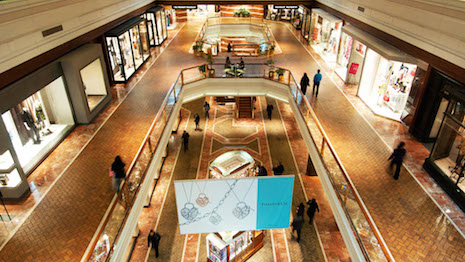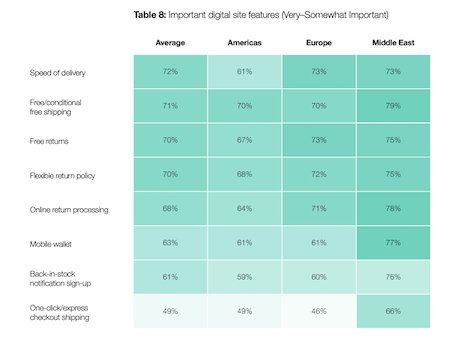 Astound Commerce's latest report advises on how brands should prepare for the upcoming holiday season. Image courtesy of Astound Commerce
Astound Commerce's latest report advises on how brands should prepare for the upcoming holiday season. Image courtesy of Astound Commerce
The pressure is on for businesses heading into a holiday season framed by economic uncertainty, as consumers alter shopping habits to adjust.
Astound Commerce has released its 2022 Global Consumer Behavior Report, providing a detailed analysis of the trends most readily shifting retail's current outlook. The digital commerce specialist, which counts Adidas, Crocs and L’Oreal among its brand partners, is outlining what consumers want and how brands can prepare to engage accordingly, ahead of what the company anticipates will be a busy end-of-year spree.
"One of the top factors in determining which brands a consumer will shop with this holiday season is which brands have the best quality and selection of products," said Kylee Magno, Principal Analyst at Astound Commerce, New York.
For this report, Astound surveyed 1,000 global shoppers from Canada, Mexico, the United States, Germany, Italy, the Netherlands, Switzerland, the United Kingdom, Saudi Arabia and the United Arab Emirates, gauging how consumer shopping habits have changed to gain an understanding of where future behaviors will land.
Less is more
Besides the threat of an impending recession, Astound’s Global Consumer Behavior Report cites political turmoil, ongoing inventory shortages and concerns over climate change among the variables top of mind for consumers heading into the second half of the year.
Nearly three in four global consumers feel the economy is on a downturn, and one-third of customers plan to reduce their spending as a result. Thus, this year’s fiscal environment makes it all the more imperative for brands and retailers to nail their holiday approach.
 Consumers will opt for certain brands based on loyalty level, prices and quality this holiday season. Image credit: Simon Malls
Consumers will opt for certain brands based on loyalty level, prices and quality this holiday season. Image credit: Simon Malls
For those who are indulging, brands should pay particular attention to how. Experts continue to see COVID-19’s impact reflected in the popularity of BOPIS (buy online, pickup in-store) and curbside pickup; roughly one-third of global shoppers are still using these shopping methods.
Other conveniences that brands can consider offering include livestream shopping, contactless payment, buy now, pay later, mobile app enabled-purchasing and social media product listings.
Following the pandemic’s height, however, consumers are generally less panicked about shopping in-store than they have been for the last two years, and intend to employ a mix of in-person and online browsing.
With financial concerns abound, Astound suggests that brands looking to survive the final few retail months of the year should seek to make alternative shopping methods, as well as the physical store experiences, as seamless as possible for consumers whose pockets may be a bit tighter.
Sustainable fashion tops the list of items consumers are still willing to pay more for, in addition to eco-friendly furniture & housewares. Global markets are fielding a growing interest in sparing the environment, with 68 percent of consumers worldwide willing to shell out more for a sustainable product, and 65 percent willing to part with up to 20 percent more.
"When asked 'how likely would you be to purchase sustainable products in each of the following categories,' luxury was one of the top two categories at 34 percent," Ms. Magno said. "Penetration was even higher at 40 percent for Gen Z, who are willing to spend more for high-quality items that provide uniqueness compared to buying multiple items they will throw away within a few months."
Among the tools at the industry's disposal, data can also help brands looking to stay hot in cool conditions, giving brands leverage in their ability to personalize shopper options.
While 62 percent of those surveyed feel that online brands appear to be transparent in their use of personal data, and more than half are willing to offer this data in exchange for a more tailored shopping experience, the same percentage will leave a website if they sense that their data is at risk.
 Graph detailing the digital features that matter most to consumers. Image courtesy of Astound Commerce
Graph detailing the digital features that matter most to consumers. Image courtesy of Astound Commerce
Supply chain delays are another potential point of tension.
"Brands need to be transparent around inventory status and shipping timeframes," she said. "These days consumers are more understanding when it comes to supply chain issues, but aren’t as willing to overlook last minute out of stock notifications or orders that arrive later than expected."
Lastly, fit and size issues continue to plague the digital domain, taking two out of three top spots of factors that contribute to the return of goods purchased online. Detailed product descriptions and imagery, plus easily accessible product reviews, could work to deter returns, according to consumers surveyed.
"Returns are another area where a brand can shine," she said.
"Customers want the process to be seamless and efficient and suggest that brands include a return label with their order, [and] provide tracking for the returned order, [enabling consumers] to be aware of what stage of the process their return is in, as well as provide the ability to schedule a courier service to pick up their return," she said. "Allowing curbside returns at the physical store (where applicable) is also of interest."
Data-driven experiences
Astound recommends looking for opportunities to build loyalty alongside the two other areas of focus – reducing friction and using data to personalize – as the final key to holiday success.
“Forrester x Resonate | What It (Really) Takes to Keep Customers Faithful,” a recent joint webinar hosted by the leading market research firm and its AI-driven consumer data intelligence partner, emphasized the use of not more, but better, data to gain a deeper understanding of the customer, thus creating seamless individualized experiences that keep them brand loyal (see story).
Maintaining an individualized, high level of customer service is the ultimate gift brands can give for the holiday.
"Make sure customer service is stellar," Ms. Magno said. "People should be available to assist, whether online via live chat or text, over the phone or in-store."
"Customers not only want, but demand a personalized and engaging shopping experience."